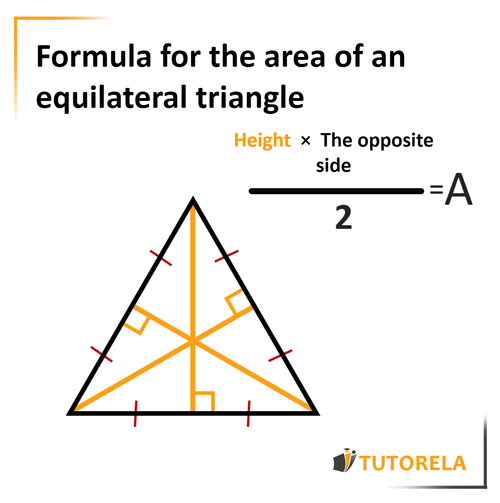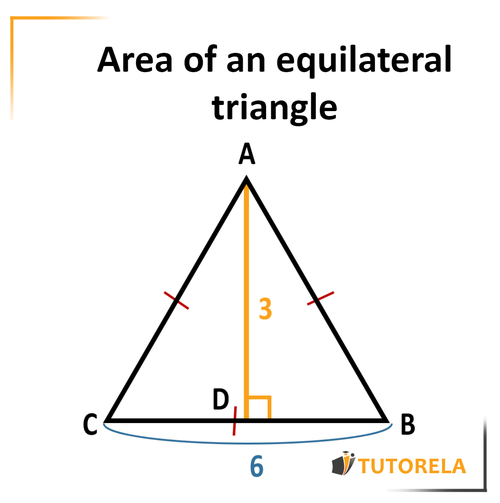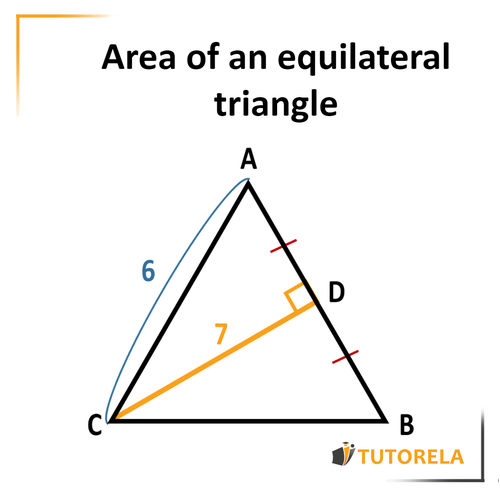Formula to calculate the area of an equilateral triangle:

The triangle ABC is given below.
AC = 10 cm
AD = 3 cm
BC = 11.6 cm
What is the area of the triangle?
Calculating the area of an equilateral triangle is quite simple, you can't get too confused with it, not even a little.
All you need to remember is the formula we will present to you below and apply it to equilateral triangles:

Remember!
In equilateral triangles, the height is also the median and the bisector.
Therefore, if the question only gives the length of the median or the bisector, you can immediately deduce that it is the height you need to place in the formula.
And on top of that, since the triangle is equilateral, you can immediately find the length of the edge (or side) corresponding. Simply compare it with the given edge since they are all equivalent.
Let's practice so we can understand even better how to calculate the area of an equilateral triangle:
Given the triangle

Given that:
Equilateral triangle
Height
What is the area of the triangle?
Solution:
At first glance, we see that we have a height equivalent to and a side equivalent to .
Let's put it in the formula and we will obtain:
Answer:
The area of the triangle is cm2.
Simple and easy, right?
What is the area of the given triangle?
What is the area of the triangle in the drawing?
Calculate the area of the triangle ABC using the data in the figure.
that covers various hypothetical situations that could confuse you on the exam:
Given the equilateral triangle

Given:
What is the area of the triangle ?
Solution:
We know that to calculate the area of the triangle, we need to have the length of the height and the corresponding side with which it forms degrees.
In this exercise, it is not explicitly stated that is the height of the triangle, but we know that: that is, is the median - it crosses the side it touches, dividing it into two equal parts.
Since it is an equilateral triangle, the median is also the height of the triangle, and therefore, we can use it in the formula for calculating the area.
Additional note: If instead of the data that is the median, they had given that it is the bisector , we could also have deduced that it is the height, since in an equilateral triangle, the median, the height, and the bisector coincide.
Therefore, we will note as the height of the triangle.
Now we must find the length of the side
Since it is an equilateral triangle, all sides are equal, so we immediately deduce that
Now let's put it in the formula and we will get:
Answer:
The area of the triangle is cm2.
The triangle ABC is given below.
AC = 10 cm
AD = 3 cm
BC = 11.6 cm
What is the area of the triangle?
The triangle we are looking at is the large triangle - ABC
The triangle is formed by three sides AB, BC, and CA.
Now let's remember what we need for the calculation of a triangular area:
(side x the height that descends from the side)/2
Therefore, the first thing we must find is a suitable height and side.
We are given the side AC, but there is no descending height, so it is not useful to us.
The side AB is not given,
And so we are left with the side BC, which is given.
From the side BC descends the height AD (the two form a 90-degree angle).
It can be argued that BC is also a height, but if we delve deeper it seems that CD can be a height in the triangle ADC,
and BD is a height in the triangle ADB (both are the sides of a right triangle, therefore they are the height and the side).
As we do not know if the triangle is isosceles or not, it is also not possible to know if CD=DB, or what their ratio is, and this theory fails.
Let's remember again the formula for triangular area and replace the data we have in the formula:
(side* the height that descends from the side)/2
Now we replace the existing data in this formula:
17.4
What is the area of the given triangle?
This question is a bit confusing. We need start by identifying which parts of the data are relevant to us.
Remember the formula for the area of a triangle:
 The height is a straight line that comes out of an angle and forms a right angle with the opposite side.
The height is a straight line that comes out of an angle and forms a right angle with the opposite side.
In the drawing we have a height of 6.
It goes down to the opposite side whose length is 5.
And therefore, these are the data points that we will use.
We replace in the formula:
15
What is the area of the triangle in the drawing?
First, we will identify the data points we need to be able to find the area of the triangle.
the formula for the area of the triangle: height*opposite side / 2
Since it is a right triangle, we know that the straight sides are actually also the heights between each other, that is, the side that measures 5 and the side that measures 7.
We multiply the legs and divide by 2
17.5
Calculate the area of the triangle ABC using the data in the figure.
First, let's remember the formula for the area of a triangle:
(the side * the height that descends to the side) /2
In the question, we have three pieces of data, but one of them is redundant!
We only have one height, the line that forms a 90-degree angle - AD,
The side to which the height descends is CB,
Therefore, we can use them in our calculation:
36 cm²
Calculate the area of the right triangle below:
Due to the fact that AB is perpendicular to BC and forms a 90-degree angle,
it can be argued that AB is the height of the triangle.
Hence we can calculate the area as follows:
24 cm²
Calculate the area of the right triangle below:
Triangle ABC is shown below.
BC is equal to 5 cm.
Side AD is equal to 4 cm.
Is it possible to calculate the area of the triangle? If so, what is it?
Calculate the area of the following triangle: